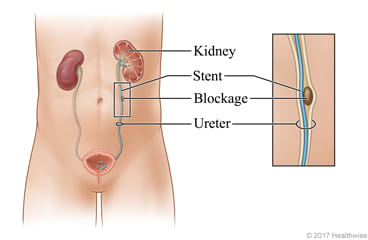
What is a ureteral stent?
Normally, urine passes from the kidneys to the bladder through a tube called the ureter. But sometimes the ureter can be blocked. The blockage may be caused by problems such as a kidney stone, a tumor, or an infection.
A ureteral (say "you-REE-ter-ul") stent is a thin, hollow tube that is placed in the ureter to help urine pass from the kidney into the bladder. The stent keeps the ureter open. After the stent is placed, urine should flow better from your kidneys to your bladder.
The stent may be left in place for several days. Or you may need it for several months. Your doctor will take it out when you no longer need it. Or, in some cases, it may be taken out at home. You may also need to have the stent replaced.
How is a ureteral stent placed?
The stent will be placed during a procedure in an operating room. You will get medicine to prevent pain during the procedure. You may also get medicine to make you sleep. You will probably be able to go home the same day, but you might need to stay overnight.
The doctor will place the stent by guiding it up the urethra. The urethra is the tube that carries urine from the bladder to outside the body. Then the doctor will pass the stent through the bladder and ureter into the kidney. The doctor will place one end of the stent in the kidney and the other end in the bladder.
What can you expect after placement?
After the placement, you may have a small amount of blood in your urine for 1 to 3 days. While the stent is in place, you may have to urinate more often, feel a sudden need to urinate, or feel like you can't completely empty your bladder.
You may feel some pain when you urinate or do strenuous activity. You also may notice a small amount of blood in your urine after strenuous activities. These side effects usually don't prevent people from doing their normal daily activities.
You may have a thin string coming out of your urethra. This string is attached to the stent. Try not to pull on the string. It will be used to pull out the stent when you no longer need it.
How is it removed?
There are several ways to remove the stent. If it has been in place for a while, you may have an X-ray to see if the stent is smooth or if it has become lined with a crust. This crust can make it harder to remove the stent.
Some stents can be removed with an attached string that comes out of your urethra. In some cases, if your doctor recommends it, you will be able to remove the stent at home. Or your doctor will remove it with the string in the doctor's office or hospital.
If there is no string, you will need to have a procedure to remove the stent. It's done using a thin, lighted tube called a cystoscope, or scope. The doctor inserts the scope into your urethra and on into the bladder. The scope allows the doctor to check areas of your bladder and urethra that usually don't show up well on X-rays.
Your doctor can also insert tiny tools through the scope to remove the stent. You may get medicine that relaxes you or puts you in a light sleep. The area where the scope is inserted may be numb. You will probably be able to go home the same day.
What can you expect after removal?
After the stent removal, you may need to urinate often. You may have some burning during and after urination for a day or two. It may help to drink lots of fluids (unless your doctor tells you not to). This also helps prevent a urinary tract infection.
Slightly pink urine is common for several days after removal.
Ask your doctor about medicines for pain.
Current as of: April 9, 2025
Author: Ignite Healthwise, LLC Staff
Clinical Review Board
All Ignite Healthwise, LLC education is reviewed by a team that includes physicians, nurses, advanced practitioners, registered dieticians, and other healthcare professionals.

